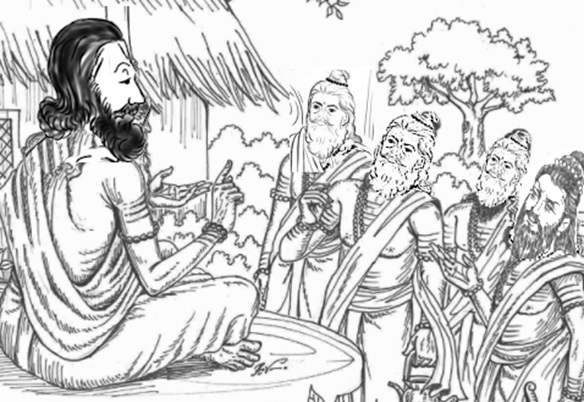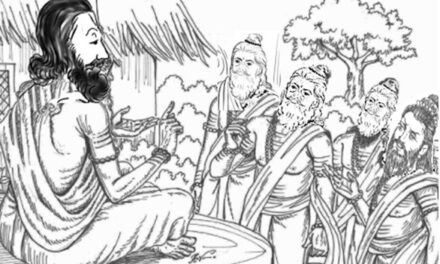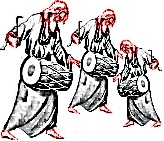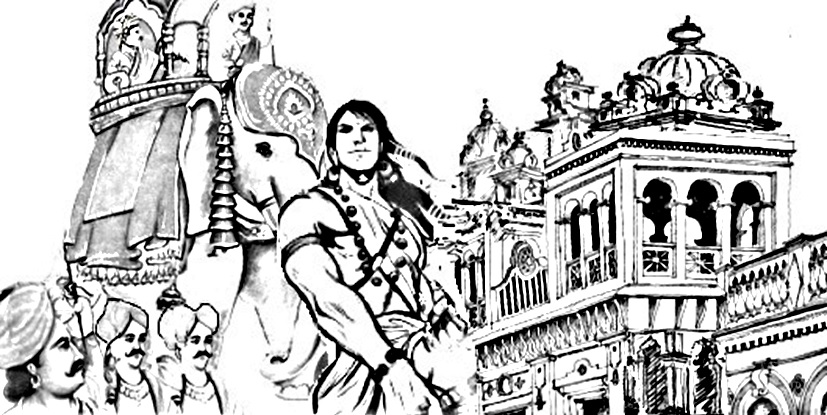

Dasaratha cursed
Self disciplined Dasaratha who succeeded Ayan, ruled his folks in righteous glory spreading his power far and wide, wisely subduing his foes in the nobler manner. As Ayan’s worthy son, he led his thunderous army to nooks and corners of the world, expanding the boundaries of his Kingdom and keeping the folks happier which included the territories conquered by him. At the same time, he held no illness in his heart even to the defeated. In the climate of peace, years rolled over and Dasaratha spoused Kausalya, virtuous daughter of King Kosala; Kaikeyi, and Sumithra virtuous daughters of Kings of Kekaya and Magadha respectively. For several years he led happier life with his partners but fate raised its ugly head in Dasaratha’s life at one point of time.
In the season of spring when new born flowers deck the earth, deeply passionate Kings, in hunting spree reach out to the Jungles when stray animals roam in woods which used to be lush green, adding beauty to the forest trees up nature’s beauty, amid the whistles of flowing rivers. On one such season, King Dasaratha armed with men, forest dogs and hunter’s net reached the jungle in hunters joy. Welcomed and watched by the Gods in jungle, thunderous bowstring of Dasaratha twanged deadly arrows quickly, chocking yawning and yelling throats of soft and fierce animals wherever they were spotted. As the enthralled King’s hunting spree continued, for a short while the hunter team rested under a tree, when gurgling sound of an elephant as if it was quenching her thirst drew the attention of Dasaratha sitting far away from the sight of the sound. Quickly raised Dasaratha, sharp shooter on target and whose skill is unmatched on earth, released an arrow from the bowstring, pointedly hitting the target from where the sound came. ‘Oh, father’ rang a cry and shocked Dasaratha rushed to the site to find its source, a young lad in teens lay bleeding in reeds pierced by his arrow. In faltering tongue, the mortally wounded boy, with a jarful of water lying by his side pleaded with folded hands ‘Oh, King, I am carrying the jar of water to quench the thirst of my blind parents whom I carry on my shoulder as they cannot travel of their own. Please rush to them with this jar of water and quench their thirst’. The boy instantly became lifeless.
Shocked Dasaratha quickly carried the martyr son along with the jar of water to the blind parents and on behalf of their son offered water to drink without telling the dreadful manner in which he unwittingly slayed their son. Unconvinced that a stranger, in the absence of their son offered the water, the blind couple were determined not to quench their thirst unless their son appeared there to offer it with his own hand. Unable to convince them, Dasaratha had no option but to reveal his identity and rehearse the dreadful fall out in which he unwittingly slayed their son. He sought their pardon to the unwitting act. The blind parents broke down and sobbed uncontrollably before breathing last, but not before releasing a vengeance filled curse ‘Oh, King, when age comes on you, like how you have thrust grief on us by slaying our son, so will you too grieve by your offspring’. Meekly absorbing the doom, childless then, King Dasaratha paid last tributes to the blind parents and their son and sorrowfully conducted the final rites before retiring back to his palace.
Long ruled the King for sixteen years in fadeless splendor, yet to pay the debt he owed for the curse he gained, no son was born to him till then. As he was left with no issue, he yearned for a worthy son and began the rite ‘Puthra Kameshwara yagya, a sacrifice done to beget an offspring, lest he will be doomed to remain debtor ever for starving his ancestors in non performing annual religious rituals (In Sanskrit it is called ‘Srartha Ceremony) due to them. When things were underway as thus, far away in pearl of ocean, flashing his arms and feet bedecked with gems of heaven, the supreme in radiance, lying on snake Shesha woke up from sleep on fate of decree to heal agonized gods in heaven, tortured by an asura in the name of Ravan. ‘Hail thee omnipotent’ shouted the demi gods and prostrated before the supreme to lament that they were sunk in the wave of rakshasas from giant demon Ravan, who not only stilled their supreme sacrifices and austere rites but also choked their hymns and toils, and bent on annihilating the demi gods and empty the heaven. ‘Our torments are monstrous’ yelled the demi gods before the supreme, and sought his intervention to annihilate the predators. The supreme consoled them, his voice rose above the thunderous roar of ocean ‘Demi gods, dismay no more and resume calm in mind. I am fully aware of the torments of the rakshasas who disturb, torture and smit down all your glorious might. In ages past, Ravan won several boons from Lord Brahma who pleased with his austere rites granted one amongst the few decrees that he will not fall dead by heavenly race, but will meet demise only the the act of a human. It is doomed that I will have to therefore incarnate as Dasaratha’s son, for he is longing for one right away and performing a yagya, and once I am born a human from the womb of his spouse, Ravana’s annihilation will be for sure to happen at my hands.
Soon, there at the yagya site, when the rites which Dasaratha performed to win an offspring reached the end, out came out from the alter fire was unknown in form, with a pot in hand and proclaimed ‘the nectar in this jar, if your wives drink, your parched feelings will disappear, filled with blossoming trees’. Quick was the response by Dasaratha who received the jar and rushed to offer it to all three wives, none of whom too wasted time to drink it. In the next ten months in waiting, they offered off springs like Rama from Kausalya, Bharatha from Kaikeyi and Lakshman and Sathrugan from Sumithra. While Rama and Lakshman remained natural allies, Bharatha and Sathrugan were the other pair though all the four grew in fostering care of parents revealing in the passing period, all kinds of disciplines and self restraint needed for royal kids.
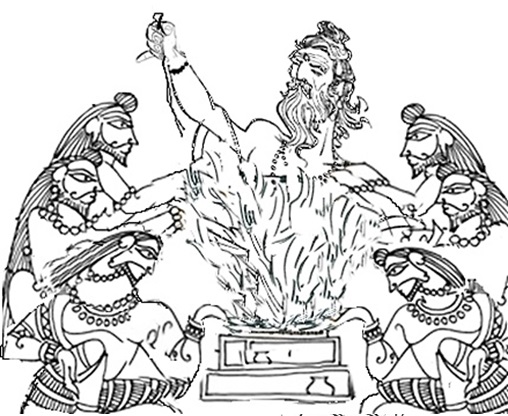
Vishwamithra holds Yagya; Rama attends Sita’s Swayamvara
So, the years rolled on and the young charming lads with dark curls on head grew well, remaining dissevered from each, learning all arts and crafts of the Kingdom under perfect masters, when on one fine morning Raja guru Vishwamitra reached Dasaratha with a request. His sacrificial rite was marred by demons and he prevented from performing an important yagya, and therefore to guard the yagya site from the predators he needed the assistance of Rama and Lakshman, the mighty warrior young pair to guard his site. Shocking was the plea to Dasaratha whose longing for an heir apparent fructified only after many years of torturous sacrificial rites, and harm if befell on the young lads during surveillance on the site will cast doom on him again as the curse of the blind couple still hanged above his head like demon’s sword. Hesitant Dasaratha offered instead royal force to guard the site, but Raja guru declined the substitutes and rose from his seat to bid farewell to the offer of the King which tantamount to refusal to his plea for dispatch of Rama and Lakshman. Placid saint sage Vashishta, quickly realizing the deeds of the invidious offer, counselled Dasaratha to allow the archer boys to go with Raja guru as demanded and a reluctant Dasaratha, eyes bedewed with tears had no option but to bow to the advice of saintly sage.
The barefooted archer boys then walked untired behind the glorious saint, stepping into rough terrain, even though they trode only on smooth and well laid floors till then. Then they entered Taraka’s land where the ferocious, tyrannic and ugly looking demon maid waylaid them. As she swooped, and rushed fiercely pushing the wayside trees with gruesome screech, for a moment Rama was hesitant to slay a maid when sage Vishwamitra had to amplify the treacherous character of the maid to the warrior heroes, and lamented that their (Rama and Lakshman) marching with him will be farce if the demon maid be left non slayed. Thence Rama wasted no time to fly his shaft that cleft her body in a whisper, pushing her down on to the earth, motionless. The demon maid’s slaying shook Ravana’s Kingdom and her horrified brethren Maricha and Swagu came rushing with their magic art and weapons with a huge force to crush the princely boys, but they too bit the dust in quick response by their prowess of the two lads. Thus ended the halls of resistance as the princely boys stood firm to their ground to guard the sacrificial site from all disturbing foes and to let the sage perform his sacred sacrifice unimpeded.
When the sacred rites thus performed unimpeded, Raja guru solemnly blessed the hero boys and in a simultaneous coincidence, the King of Mithila bade the sage to bless the occasion on the great sacrifice performed by him, a convention to engage wed lock for his daughter. His daughter Sita will hold the hand of one who lift and bend the mighty Sivadunus (Bowstring given by lord Siva) he possessed. Mithila King pleaded for the august presence of the saintly sage to bless him to perform the sacrifice in perfection and peace. Yielding to the King’s plea, Vishwamitra the saintly sage began his march to the site accompanied by the warrior princes who were too young and non invites, but accompanied the sage as his disciples.
On way they marched, the curse on Agalya, spouse of sage Gowthama was also released by the accidental touch of Rama’s feet and the sage amplified the cause of her curse to Rama. So said the sage to Rama ‘The maid re birthed was spouse of sage Gowthama, who caused the curse in anger when he chanced observed his wife’s modesty stained, when in a moment of flicker, she faltered on the beauty of lord Indira. Absorbing the curse Agalya turned into a stone and doomed to regain her form only after ages when the dust of your feet fall on her and thus Agalya’s curse erased today with dust of your feet’. Her forms reversed, Agalya, prostrated at their feet and profusely thanked them, but she left not alone and ensured safe passage to rejoin with her lord, sage Gowthama by the accompanying princes with the sage. Thence from sage Gowthama’s dwelling began their intent march to Mithila.
When King Janaka heard of the saint marching to Mithila, he met them on road, extended warm welcome paying due honour. On way to the palace hall, the sage hailing the mighty valor of Rama simply said ‘King you will see proof of his valor upon performing the magic on the mighty bowstring kept displayed’ and the King pleased to hear the proclamation of the sage lost no time in extending his invitation to Rama to take part in sacrifice. Even before Rama acknowledged the invite, his guardian sage Vishwamitra on behalf of Rama declared ‘yes King, Rama will test and try’. Intent not held in lips, the sage indeed accompanied Rama to the scene. There in the hall, anxious looking assemblage heard in rapt attention Janaka’s declaration ‘My salutations to all assembled, noble kings and princes. The sacred bow and arrow, gift of mighty lord Siva will select the suitor to hold my daughter’s hand, who was not born on earth, but gifted to me during ploughing, and she will be the prize catch to those who lift and bend the sacred bowstring are-showed (displayed).
All the princes who had assembled there hoping to lift the bow and marry Sita went to the middle of the assembly one after the other to lift the bow; alas everyone failed, and therefore sat down with a sullen face. Seeing none succeeded, Janaka also remained depressed and lost hope of his daughter getting married; he thought that Sita would never get married again. Then Vishwamitra commanded Rama to go and lift the bow. Rama bowed at the feet of Maharishi Vishwamitra, got up and reached the spot to lift the bow. When everyone of the mighty princes failed to lift the bow, none were willing to believe that Rama, who was younger to all of them, would achieve the fete. After paying homage to Janaka, who was sitting there, without showing any emotion on his face, Rama easily lifted the bow, bent it and broke it. Everyone shouted with joy and Janaka was charged in emotion to see Rama succeed. Everyone were elated and rejoiced on hearing the series of events and valor of the twin brothers that ultimately led to Rama’s wedding with Sita. The folks and counsel of King Dasaratha offered Rama and Lakshman a grand reception along with the saintly sage Vishwamitra who was instrumental in getting them the glory they deserved.
Parasurama’s pride banished
Events unfolded rapidly. King Dasharatha, along with his retinue and the royal guru Vashishta , arrived in Mithila where the marriage of Sita and Rama was solemnized. Lakshman married the Urmila, while Bharatha and Shatrughna married Mandavi and Sudhakirthi respectively. After the wedding, when they were returning home, they were confronted on way by Parasurama who challenged ‘Oh brave warrior, I have come here after destroying all Kshatriyas responsible for my father’s death; only you and Karthaveeryan are left to be killed. Since you and I share the same name as Rama, I am hesitant to kill you. You may have broken the weak bow of Shiva dhanush which was with Janaka and married Sita; it does not show your real strength. Look at this bow of Vishnu which I have. If you hold it in your hands, bend and string it, I will acknowledge you to be a true warrior who has defeated me. Thereafter you can continue with your journey’ Accepting the challenge, Rama told Parasurama, ‘Venerable sage, you are elder to me; I will not kill you even if I hold the bow and string because you are not only a brahmin but also related to Maharishi Vishwamitra who is our revered master (Guru). Killing some one related to a Guru will be tantamount to treason and the sin will not get pardoned in any manner. Therefore, before I lift this bow, please fix the reward for the act, whether it could be ‘Pada Gathi’ or ‘the land which you have conquered till now’?”
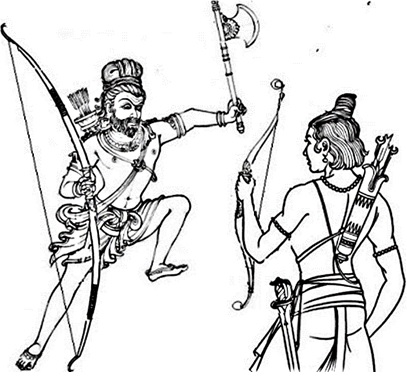
Parasurama, was actually the sixth incarnation of Lord Vishnu. He set out to avenge the Kshatriyas who killed his father, beholding within him all aspects of anger of Lord Vishnu. Thus, he had gained a unique power of reaching any place he wished to go in wink of an eyelid. Such a power was called ‘Pada Gathi’
Parasurama’s guru was sage Kashyapa. Parasurama had gifted all the lands he had conquered to his guru Kashyapa as a Guru dakshina (offering made to a teacher). While receiving the same Kashyapa put forth a condition that Parasurama can visit the areas he has gifted, but he shall not stay there overnight. In view of such a condition, Parasurama exercising his extraordinary power of Pada Gathi used to reach areas beyond Mahendra hills which was the boundary of the place gifted to his guru during night period of time. Parasurama did not wish to forego both of those proposed by Rama, instead he offered to give away the Swarga Gathi which he had attained by his arduous tapas. This means when the human life cycle of Parasurama ended, his direct path to reach heaven will remain blocked.
Accepting Parasurama’s offer Rama took the bow from Parasurama, lifted it, and strung a noose on it to defeat Parasurama. Parasurama’s pride got destroyed; he instantly understood that the Rama in front of him was also the incarnation of Vishnu. He therefore raised his hands and blessed Rama and allowed him to proceed on his way. Realizing that his end had come, Parasurama himself sacrificed the fruits of his penance to the bow which Rama had lifted. Rama, along with his wife and retinue, fell at Parashurama’s feet and offered his obedience to him. After accepting the blessings from Parasurama, he returned to his country.
———–
* A brief explanation:-
It does not mean that parting away of Swarga Gathi prevented Parasurama from going to heaven. It only disallowed him to straight away go to heaven after his demise. But he could choose another path to travel there, which means that he may take few more moments to achieve the end. The divine can not afford to lose even one second in their life which will be equal to several human years. One can ask why the divines who are said to control everything, can not foresee in advance all such things? According to the Puranas, everything that happens around the divine is the play of the divines themselves. The gods perform such divine plays to teach the human, the acts of action-reaction theory.
When the incarnation of Parasurama neared the end, he realized that the time had come to offer his power to Rama, the next in line of incarnation to Vishnu. Therefore, he enacted such a drama and after getting defeated at the hands of Rama, when Parasurama raised his hands to bless him, he transferred all his powers to Rama incarnation, since Lord Vishnu cannot perform his duties by keeping all his powers in two different human incarnations at the same time.
Even when Parasurama blessed him, Rama did not realize that he was the incarnate of Vishnu. Similarly, everyone considered Rama to be human. Had Rama known that he was an incarnation of Vishnu, he would not have chosen to defeat Parasurama, who was senior to him.
When the folks came to know of the events which delayed Rama’s arrival, they felt joyous over the valor of Rama and welcomed him along with his brother Lakshman who stood with Rama, like his shadow in both good and bad times. They also gave a grand welcome to sage Vishwamitra, who was instrumental in getting the bravery, courage and pride of Rama and Lakshman revealed to everyone. They honoured him in many ways, worshipped him and praised him and expressed their joy.
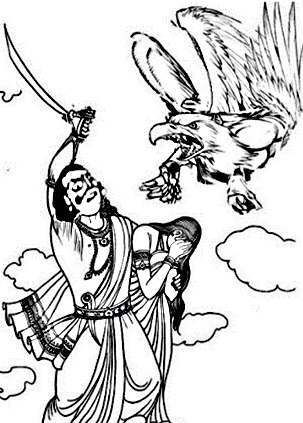
Rama Banished; Jadayu martyred; Ravana’s death
Everyone were elated and rejoiced on hearing the series of events and valor of the twin brothers that ultimately led to Rama’s wedding with Sita. The folks and counsel of King Dasaratha offered Rama and Lakshman a grand reception along with the saintly sage Vishwamitra who was instrumental in getting them the glory they deserved. Passing few more period, Dasaratha having drunk life’s pleasure longed for austere life after enthroning Rama as his heir, but doom would not let it go and showed its ugly face in the form of an hag called Kooni on whose treacherous counselling, Kaikeyi, Dasaratha’s wife and mother to Bharatha interposed two past resolves of Dasaratha to gain his consent to banish Rama and Sita for fourteen years and they be commanded to lead austere life in woods, followed with the demand of throne for her son Bharatha. The promise thus taken when thrust upon, Rama received the doom of exile with his faithful wife and his brother Lashman with all cheerfulness and thereafter went into exile.
Heart broke Dasaratha, unable to bear the agony of his sons in exile, after a short while breathed his last. For noble Bharatha however the seat of power was anathema as his lovable brother was Rama, who as per Bharatha deserved to wed the realm (Throne) which was denied at the ugly machination of Kooni, and therefore travelled to the wood to inform his brother, of his father’s passage to heaven and urging Rama to return and wed the realm. But noble Rama would not yield and bound himself with the solemn oath administered to his father now departed. When long urges and pleads did not melt the mind of Rama to return and wed the realm, Bharatha sought his sandals instead, affirming that the sandals will hold the realm till Rama returned, lest Ayodhya’s folks suffer. Pure Bharatha not grasping for the realm, agreed to return and rule the folks till Rama returned, but resolved that Rama’s sandal to be the Monarch, and he be the administrator on behalf, thus making expiation for his mother’s crime.
There in the woods, Rama lived with content in austere life with rigid vows and his wife Sita and brother Lakshman backing while sustaining on forest foods and serving hermit Athri maharishi for some time. While in Panchvati, there came Ravana’s sister Soorpanaga, love sick maid on Rama and longed to have him her mate, and constantly troubled them even after Rama cautioned her to desist the temptation which when failed left her with no choice but to face the wrath of his brother Lashman who tore her nose and ears off from face before driving her away from there. When she fled and sought help from Ravana, the enraged Demon dispatched fierce demon force to contain the twin brothers, but the invaders too were driven back in same speed they came attracting death dealing blows. At the same time hearing of the beauty of Sita, Ravana desired to have her for him and thus his wicked mind set laid the foundation for his destruction to fulfill the doom due for him as vowed by Lord Vishnu before incarnating as Rama.
Thereafter Ravana directly took to the field, decoyed Rama with the help of Maricha who posed as Deer in magic art and kept Rama away from his hut thereby helping Ravana carry away Sita and imprison her in his fortress as she turned away her face from him even as his vain attempt to lure her with tales of his own mighty valor and strength of wealth failed to appease her.
On way to Lanka, Ravana gravely injured and cut off the wings of mighty Jadayu who confronted him in an attempt to save Sita. The twain (Rama and Lashman) when learnt the episode from martyr Jadayu mourned his demise and paid homage but not before rearing a lofty pyre as for a parent funeral and thereafter in alliance with Monkey King Sugreeva’s army, commenced frisking earth to track Sita. Disconsolate Rama earned the strength of Monkey force when he intervened in the brotherly war over the Kingdom between Sugreeva and Vali, and restored the Kingship to Sugreeva, whose land Vali usurped earlier. Nor was Rama gainer of the Monkey force alone, Hanuman, who loved Rama from the bottom of his heart and mind too was a prize catch with whose help Sita’s den of imprisonment was discovered. Then the twain travelled to Lanka with the Monkey forces and shattered the demon forces of Ravana, there in the midst of war vanquishing the mighty demons like Indrajit and Kumbhakarna before killing Ravana with the aid of Ravana’s brother Vibhishana. Rama thus rescued his beloved bride and returned back to Ayodhya when the fourteen-year exile came to an end.
Sita Banished; Kingdom restored; Lava-Kusha born
After Ravana was slain, Rama along with Sita travelled in the magic car- Pushpak vimana- which passed through various places which Rama’s feet touched while in search of Sita. On way home during travel Rama lovingly pointed out to Sita the patches of the peaceful hermitages of saintly ascetics, place of their exile, where Maricha in magic form was rested, Jadayu’s martyrdom, Sugreeva and Vali’s land, Hanuman’s surrender and foaming waves and waterspouts of Ganges, Rivers Saraswathi and Sarayu etc. When they reached Ayodhya, they were warmly welcomed by Bharatha who gave back the Kingdom to Rama, which he was administering in Rama’s absence and Rama had no hesitation in taking over the Kingdom. Soon when Sita conceived, the folks rejoiced on hearing the happy news. Generous King Rama’s land was a happily ruled state and like a dream, the days flew past.
Once Rama called his loyal follower (spy) and sought to know what his folks felt about his rule. The loyal servant proclaimed that the folks were happy lots in all spheres of life and while they praised the King abundantly, but their dismay was how pregnant remained Sita, whom Rama accepted without semblance of doubt, even after her long sojourn in Ravana’s palace. That slanderous feeling imputing foul disgrace to them smote Rama’s heart with crushing force.
Rama wavered for long and summoned his brethren to take their views whether to despise the slanderous talk or to keep the stain upon? Deeply pondering all implications, with heavy grief, but expressed not and held in heart, Rama declared his stern resolve to dismiss his pure Queen and ordered his womb filled spouse to be left in sage Valmiki’s dwelling to dwell in dense woods under his care. During course of time Sita delivered twins who were named Lava and Kusa by sage Valmiki.
So Sita banished, like ice melting in heat, the time melted, when one day some ascetics came to Rama and sought his help to banish demon Lavanya, son of Kumbesini, sister to demised demon Ravana as she was destroying their rites and sacrifices. Rama unhesitatingly dispatched his brother Sathrugan to destroy demon Lavanya. Sathrugan obeying the command of the Monarch reached the woods and stayed with sage Valmiki to successfully accomplish the task, during when he chanced upon to hear the news of twins to Sita which enthralled him, but mission foremost in mind, he successfully accomplished the task of eliminating Lavanya and on way back to Ayodhya, for a while he returned to his Kingdom to rule for some time before handing over the realm to his sons Swagu and Vegusarugu. Thence self restrained Sathrugan when returned to Ayodhya he received infinite praise from the ascetics for his gallantry in vanquishing Lavanya, and narrated events to Rama, but since sage Valmiki had restrained him from divulging facts on Rama’s twin sons Lava and Kusa to anyone, Sathrugan held the news to self as the sage himself will bare all facts at appropriate time. Sage Valmiki taught word after word covering all sacred lores and what not to the twins besides the recital of Ramayana* to both Lava and Kusa.
As time passed, there in Ayodhya on a fateful day, a Brahmin brought his dead son, placed him before the palace passage and moaned aloud ‘Oh, wretched earth, how do you gulp even after watching bad turning into worse and unnatural deaths occurring under the present King’s rule where as such sins were mirage under his father’s grasp’. His loud voice reverberated the walls of Rama’s Palace.
Hearing the Brahmin’s plaint, Rama came rushing from the Palace gates to assuage the moaned ‘ Oh, Brahmin, be sure, I will seek out death and bring your son again’. Thus, proclaimed Rama summoned his Magic car loaded with deadly arms and set to proceed to Yamalog (Torture den in the world of King Yama who rewards punishment for sins), when a warning voice from heaven spoke ‘Hold, King, hold. Great sin defiles your land. Search the sinner and crush him. Once done, you will be rewarded the wish you declared’. Thus spoke, the voice muted.
Heavenly voice heard thus, Rama flew in all directions in search of the sinner to take away the sin and continued to travel till he reached a remote place to see a self tormented man in penance, his head hung down from a tree. That was the sin, the style of penance transgressed the forbidden law of penance. Quick was the reaction of Rama who pulled out his sword and cut off the head of the sinner to wipe out the foul transgression with the death of the unknown. In moments, the news of Brahmin’s son restored to life was received to the rejoice of Rama who returned to the Palace fully satisfied when the unknown and appeased Brahmin too departed from there after showering choicest blessings on Rama.
—– *Brief Clarification:-
The incident which prompted sage Valmiki to compose Ramayana is related to an interesting story:
Once when Valmiki went to the banks of River Tamasa, he happened to notice a pair of doves engaged in the art of mating. Suddenly, he saw the male bird falling down dead, shot by a hunter’s arrow. The female bird, seeing plight of the mated companion flapped her wings, and squawked piteously. On seeing the plight of the female dove, Valmiki’s grief spontaneously burst into fury to release a curse on the hunter in the form of a verse. When grief settled, composed Valmiki wondered how he unleashed curse in verse, untaught to him. As he sat wondering Lord Brahma appeared before him to command Valmiki to write the divine story of Rama which will remain ever cherished and revered by mankind till the earth and mountains thrived. Accepting the mandate Valmiki sat in solace and closed his eyes when the entire sequence of Ramayana, commencing from the birth of Rama to Sita’s banishment sailed in his inner eyes. He deeply etched the entire events in heart and taught memorized Ramayana to his disciples Lava and Kusa. The scholars believe that Valmiki Ramayana in original consisted of story till Sita’s banishment and events beyond may have been composed and added with Valmiki Ramayana in later years by unknown composer(s). In support of their view they cite that the Ramayana recited in Rama’s court by Lava and Kusa portrayed only from the birth of Rama to crowning back in Ayodhya after his return from Lanka vanquishing Ravan. However, these lores remain word of mouth stories for generations without supporting documents-Santhipriya).
Rama’s Ashwametha Yagya
Even in the midst of mire controversies here and there, Rama’s land continued to expand in territories. Then one day came sage Agasthya to counsel Rama to go for a horse sacrifice called Ashwametha Yagya to grace his folks and appease omens. Thereafter Rama let loose a horse for the great horse-sacrifice as mark of commencing the ceremony with extraordinary splendor, and showered choicest gifts and alms to the invitees who came from all directions. Lava Kusa dwelling in hermit Valmiki’s place held with them the sacrificial horse let loose by Rama after commencement of the ceremony. As per the text book rules of Vedic rites, as and when the solemn horse sacrifice commenced, the monarchs used to let loose a mighty horse to travel through the territories ruled by Royals of different races. Allowing the horse to run free and unhindered in their land will be the symbolic gesture of the royals for accepting the supremacy of the master of Yagya, and subsequently become subordinate royals to the performer. Those wish to defy dominance of the performer, block the free passage of the horse in their land to send the message ‘Let my flag flutter in my land, or you become my lord after conquering me’. The sacrifice horse thus dispatched by Rama, contained by the twins- Lava and Kusa, and held captive in hermit Valmiki’s ashram reached Rama’s ears and a wonder struck Rama inquired from the saintly sage through feelers as to who the twins were. The sage would not reveal the identity of the boys to the feelers, but promised to tear the mask once they render Ramayana in Rama’s court at the end of the Yagya, till which time Rama need to restraint self and remain calm.
Thereafter sage Valmiki dispatched Lava and Kusa to the solemn sacrifice site when it began, and the boys stirred the souls of the audience present there with their soft voice and unwinking eyes. At the end, Rama learnt from the teacher that the twins were trained by the sage. Unable to anymore abate his thirst, his brothers following, Rama met the sage in his dwelling, fell at his feet and pleaded for lifting the veil of secrecy of the twin boys, the sage broke all facts to reveal that the twins were none other but Rama’s heir only, born to Sita. Rejoiced Rama pledged his faith on Sita and requested the saint to convince Sita to return, but at the counselling of the sage, Rama decided to hold Sita’s hand in public once she wiped out the slander by proving her modesty in public at the end of the Yagna itself till which time her visit will remain a secret. However, since the presence of spouse is essential for performing any sacrifice, Rama had no choice but to keep a puppet of Sita as her presence by his side till the sacrifice concluded. When the sacrifice concluded, sage Valmiki petitioned Sita and produced before folks and addressed ‘Sita, time has come to wipe out the mud on you. Now in front of the audience establish that none but Rama alone was your breath, thought, deed, spirit and feeling even while in solitary confinement at Ravana’s dwelling, daughter, establish to the world that the sacred truth that your modesty is nothing but pure fire’.
Waiting for such an occasion, pious and pure Sita asked them to raise a huge pyre and in front of all solemnly prayed to earth ‘Fostering God of earth, my mother, hold me into you if I am as pure as fire, stainless and unsullied wife’. To the bewilderment and shock of assembly, a chasm opened in earth that appeared in glorious form, fire burning above, earth Goddess called Bhoomadevi, came through the fire and clasped her pure daughter to her breast, and vanished inside, doors of earth closed again.
The unexpected tremor enraged Rama who angrily and quickly pulled out his sword shouting for the return of his pure spouse lest, the mother earth will be doomed. In time, lord Brahma appeared before Rama and restrained him to remain calm as countdown to end his incarnation along with his brothers have begun as their tasks in earth have been fully accomplished in that incarnation, thereby signifying the divinely status of Rama la Lord Vishnu to the audience and the world. Sita has been embraced back by mother earth who gave her to Dasaratha. Sacrificial rites thus ended with reunion of short-lived divorcees, Rama was counselled to conclude the ceremony with parting noble gifts and alms to the assembly. Brahma’s advice heeded in words and spirit, Rama honoured the assembly in perfect manner and downed the curtain bading goodbye to all.
— –Small Clarification:-
There is another important message that needs to be addressed here. A virtual image of Goddess Sita was created – Vedavathi- by sage a Vashishta and sent to stay in her place when she was in the woods . Ravan abducted only virtual image of Sita and not actual Sita , it became necessary that the virtual image carried within herself some of the feelings and mannerisms of Goddess Sita, which she ably did, lest Ravana would easily detect that the virtual image was not that of Sita Devi. Immediately on the annihilation of Ravana, original Sita Devi got reunited with Lord Rama. Seconds before the drama, she absorbs the virtual image -Vedavathi- sitting under the Ashoka Vana in Sri Lanka and sits there in person (real Sita Devi) to get rescued by her husband Rama. Therefore, only the real form of Sita Devi and not Vedavathi who was the virtual image, joined with Lord Rama. Since the time was not ripe to reveal in public either the true aspects of Vedavathi or the reasons for her creation, Sita Devi maintained silence and waited till the drama entering into the fire to prove her modesty was enacted in the midst of which she came out from the fire along with her virtual image –Vedavathi- to reveal the entire truth after which Vedavati disappeared. The act of disappearance of Vedavati is only the philosophy of merging into the body of Sita.
Similarly the act and drama of Sita Devi reuniting with Lord Rama and entering into the fire did not happen immediately upon annihilation of Ravana. It takes place only after her twin sons Lav-kusa were born. For want of huge space, the detailed narrations after she gets reunited with Lord Rama has been skipped since they were all familiar stories and everyone understands them –Santhipriya).
Back to Kalidasa’s story, sullied Rama lost his balance and on the counsel of sage Yudhijit, he transferred to his brother Bharatha, entire land of Sindhu, who too ruled it only for short while before bidding farewell to the rule and to position his sons Thakkan and Purlakan on Royal chair. Similar history followed with another brother Lakshman who too parted with the Kingship to throne Anghada and Chandraketu his two sons. Not to be left behind, Rama too followed their steps to engage his twins Lava and Kusa in the ruling.
Thus Raghu brothers peacefully passed on their burden to their due and perfect successors to lead an austere life, and when the time to reach their lords in heaven came, the torch bearer in the form of sage Durvasa visited Rama. He desired one to one secret conference with Rama which when granted, met him in isolation and persuaded Rama to end his incarnation. Lashman, who stood guard at the gate broke in upon hearing their secret conversation in a haste as he staggered to hear the content and turned sad. To atone the sin of committing entry in to the secret meeting room as uninvited guest, and the fact on Rama’s end heard, sad Lashman sought their pardon and in deep devotion and love to Rama quietly walked to river Sarayu in isolation and shed his earthly venture in yogic style. The soul within his body flew to heaven.
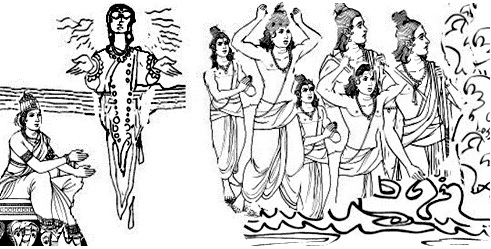
With one quarter of his earthly essence in the form of Lashman gone, who was not less than a twin though not born twins, and unable to bear his loss, Rama realized in all firmness that the time to shed the body too has ripened. Quickly he placed Lava and Kusa in firm saddle of the realm assigning the duties and one day marched to river Sarayu followed by his steadfast-souled brothers – Bharatha, Sathrugan and others and mounted up to heaven entering into the river. Thus, though ended the incarnation of Rama and other brothers after their task to slain the foes in Bhoologa (Earth) were accomplished, their lineage continued with Lava, Kusa and other sons of the faded incarnates.
—— –Brief commentary:-
One of the books, Valmiki Ramayana translated into Tamil, written in the year 1941 by an eminent author called ‘Maha Vidwan Sreemath Prathivathi Bayangaram Annangarachariya Swamigal’ of Kanchipuram district of Tamilnadu in India has mentioned under title ‘Samshaeba Ramayana’ in the first Sarga of the book that it was Sage Narada who briefed the epic Ramayana to Valmiki and thereafter, an incident that occurred in the bank of river Tamasa provoked Valmiki and prompted him to compose the Ramayana in verse form. As he was searching for suitable disciple to pass on the gem, Lava and Kusa came forward to absorb the epic.
The said Ramayana, in the form of verse portraying the valor of Rama has been reportedly composed during the rein of Rama and therefore Lava and Kusa were able to recite them in Rama’s court. However, the epic in verse did not attempt to promote Rama a divine incarnate, though the events and narration linked the folks on earth and those in heaven.
The Valmiki Ramayana in original reportedly consisted of 24,000 poems (paras of Verses) spread over seven cantos, narrations covering from Rama’s birth to his crowning ceremony. However, the mute question that remains unanswered has been whether Ramayana reportedly recited by Lava and Kusa in Rama’s court, foretold the events leading to ultimate fading away of Rama and Sita? The scholars are of the view that the verse composed by Valmiki as we have today is certainly incomplete. Tradition, as narrated in word of mouth stories say that while it is true that the Valmiki Ramayana in its original form consisted of 24,000 versus many of which have only come down to us, but the abrupt end of the verse with Rama ascending the throne confirms the belief that many pertaining to i.e. Rama’s lineage prior to his birth and after his demise may have been lost but mysteriously the same has been narrated by Kalidasa in the epic he composed much after Valmiki lived. When Kalidasa was able to narrate Raghu’s line before and after Rama’s birth and shedding of incarnation, how could Valmiki not know about them? Moreover, Kalidasa’s Raghuvamsam mentions the recital of Ramayana by Lava and Kusa and therefore one cannot brush aside the belief that perhaps Kalidasa could have read Valmiki Ramayana in full based on which his epic may have been composed and that the Valmiki Ramayana in original would have also contained the pre and post Rama clan but may have been only known to Kalidasa through Valmiki Ramayana in original.)
…………….continued-3

